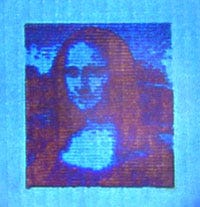December 18, 2015
A new laser printing technique now makes it possible to print high-resolution data and images with unprecedented quality at microscopic dimensions.
Kristopher Sturgis
|
Image of the Mona Lisa, printed at just 50 micrometers long, roughly 10,000 times smaller than the real painting. |
The Technical University of Denmark (DTU) believes that this new technology could serve as a significant breakthrough in the field of nanotechnology, and could soon replace most conventional forms of laser printing across the globe.
"We can control the shape and size of the nanostructures via the intensity of the laser," says Anders Kristensen, professor in the Department of Micro and Nanotechnology at DTU and one of the researchers involved in the creation of the technology. "We can modify individual disks on the surface, which gives us extreme resolutions of 127,000 DPI, compared to DPI resolutions in the hundreds for conventional laser printers."
The details of the technique involve a special nanoscale-structured surface that consists of rows with small columns that are roughly a 100 nanometers in diameter. This surface of columns is then covered by 20 nanometers of aluminum, which can be heated up when a laser pulse is transmitted between the nanocolumns, resulting in a measured amount of melting or deforming of the nanocolumns.
As Kristensen states, the intensity of the laser beam is what determines which colors are printed on the surface, due to the fact that the extent of the deformation decides what color is reflected. Low-intensity laser pulses create minor deformation of the nanocolumns, resulting in blue and purple color tones. Meanwhile, high-intensity laser pulses lead to more drastic deformations, leaving behind orange and yellow color tones.
While 3-D printing technologies may be peaking, there is still a considerable amount of untapped potential when it comes to laser printing techniques and their various applications. The group believes that the technology will enable users to save data like barcodes and serial numbers, leaving them invisible to the naked eye. It could also prove useful when it comes to combatting fraud and forgery, as well as making it easier to determine whether a product or device is authentic and original.
"Another application could be counterfeit measures for medicine," Kristensen says. "Since we replace dyes with a film of aluminum, our technology could also be safer with medicine and food."
For now the group hopes to continue their research and enhance the technique in an effort to make it both simpler and more efficient. With the technology already patented, the team is focused on improving the technique and hopes to have it available for use in three or four years' time.
"I am very optimistic, but there is still quite some development ahead," Kristensen says. "This laser printing technology opens up some new perspectives for mass production of individualized and personalized products."
Learn more about medical device trends at MD&M West, February 9-11, 2016, in Anaheim, CA. |
About the Author(s)
You May Also Like



